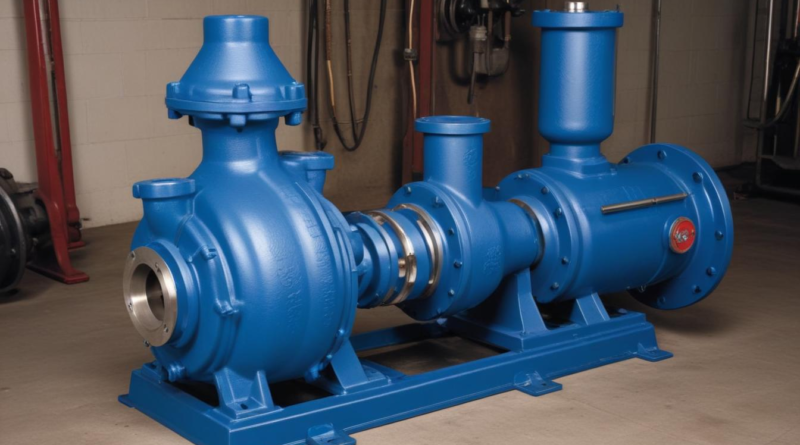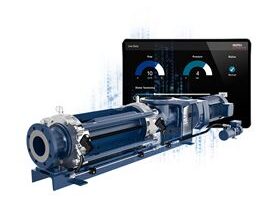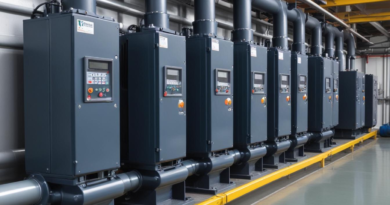how to perform pump efficiency tuning
Pump efficiency is a critical parameter in evaluating the performance and energy consumption of pumping systems. It quantifies how effectively a pump converts electrical or mechanical energy into hydraulic energy, thereby determining the overall effectiveness of the pumping operation. Understanding pump efficiency involves examining several key factors and metrics that contribute to its calculation and optimization.
The primary components influencing pump efficiency include:
- Hydraulic Efficiency: Measures the effectiveness of the pump in moving fluid, considering factors like flow rate and pressure.
- Mechanical Efficiency: Assesses the mechanical components’ performance, including bearings, seals, and the integrity of moving parts.
- Volumetric Efficiency: Evaluates the pump’s ability to transfer the intended volume of fluid without internal leakage.
- Overall Efficiency: Combines hydraulic, mechanical, and volumetric efficiencies to provide a comprehensive view of the pump’s performance.
To accurately determine pump efficiency, the following procedures are typically employed:
| Procedure | Description |
|---|---|
| Performance Testing | Conducting tests to measure flow rate, head, and power consumption under various operating conditions. |
| Energy Auditing | Analyzing energy usage patterns to identify inefficiencies and potential areas for improvement. |
| Computational Analysis | Using software models to simulate pump performance and predict efficiency under different scenarios. |
Several techniques can be applied to enhance pump efficiency, including:
- Adjusting impeller diameter to match the system’s flow requirements.
- Implementing variable frequency drives (VFDs) to control pump speed in response to real-time demand.
- Reducing system head by minimizing friction losses through proper piping design and maintenance.
- Regular maintenance of mechanical components to prevent wear and ensure optimal performance.
By thoroughly understanding these aspects of pump efficiency, professionals can effectively carry out pump efficiency tuning, leading to significant energy savings and improved system performance.
assessing current performance
Assessing the current performance of a pumping system is a foundational step in pump efficiency tuning. This evaluation provides a clear baseline from which improvements can be measured and ensures that any optimization efforts are data-driven and effective. The assessment involves a comprehensive analysis of several key performance indicators and the implementation of systematic procedures to gather accurate data.
Key Performance Indicators (KPIs):
- Flow Rate: The volume of fluid the pump delivers per unit of time, typically measured in gallons per minute (GPM) or liters per second (L/s).
- Head: The height to which the pump can raise the fluid, expressed in feet or meters. This includes both static head and dynamic head components.
- Power Consumption: The electrical or mechanical power required to operate the pump, usually measured in horsepower (HP) or kilowatts (kW).
- Efficiency: The ratio of hydraulic power delivered to the fluid versus the input power, providing insight into the pump’s performance.
- Operating Hours: The total time the pump has been in operation, which helps in assessing wear and maintenance needs.
Assessment Procedures:
To accurately assess the current performance, the following procedures are typically employed:
| Procedure | Description |
|---|---|
| Data Logging | Utilizing flow meters, pressure gauges, and power meters to continuously record operating parameters over a specified period. |
| Performance Benchmarking | Comparing the current performance data against manufacturer specifications or industry standards to identify deviations. |
| Energy Audit | Analyzing energy consumption patterns to detect inefficient usage and potential energy-saving opportunities. |
| Physical Inspection | Examining mechanical components for signs of wear, leaks, or damage that could impact performance. |
| System Analysis | Evaluating the entire pumping system, including piping, valves, and fittings, to identify any sources of pressure loss or inefficiency. |
Data Collection Techniques:
Accurate data collection is essential for a reliable assessment. The following techniques are commonly used:
- Flow Measurement: Installing flow meters at strategic points to obtain precise flow rate data.
- Pressure Monitoring: Using pressure gauges or transmitters to measure the head and detect any fluctuations or drops.
- Power Monitoring: Employing power meters or energy meters to track electrical consumption and identify peak usage periods.
- Temperature Measurement: Monitoring the temperature of mechanical components to prevent overheating and ensure optimal operation.
- Vibration Analysis: Conducting vibration surveys to detect imbalances, misalignments, or bearing issues that could affect pump performance.
Analysis and Interpretation:
Once data is collected, it must be analyzed to identify trends, anomalies, and areas for improvement. This involves:
- Trend Analysis: Reviewing data over time to identify patterns or recurring issues that may affect efficiency.
- Comparative Analysis: Comparing current performance metrics against baseline data or industry benchmarks to assess relative efficiency.
- Root Cause Analysis: Investigating the underlying causes of any identified inefficiencies, whether they stem from mechanical issues, operational practices, or system design.
By meticulously assessing the current performance through these procedures and techniques, organizations can establish a solid foundation for effective pump efficiency tuning. This thorough evaluation not only highlights existing inefficiencies but also guides the selection of appropriate optimization strategies to enhance overall system performance and energy utilization.
optimizing operational parameters
Optimizing the operational parameters of a pumping system is essential for achieving maximum pump efficiency tuning. This involves fine-tuning various aspects of the pump’s operation to align with the system’s demands and reduce energy consumption. Several key parameters can be adjusted to enhance performance:
- Flow Rate: Adjusting the flow rate to match the system’s actual demand can prevent excess energy usage. Over-pumping results in wasted energy, while under-pumping can lead to insufficient system performance.
- Pump Speed: Modifying the rotational speed of the pump directly affects both flow rate and head. Utilizing Variable Frequency Drives (VFDs) allows for precise control of pump speed, enabling adjustments in real-time based on system requirements.
- System Head: Reducing the total head required by the system minimizes the energy needed to operate the pump. This can be achieved by optimizing the piping layout, minimizing bends and fittings, and ensuring valves are fully open and functioning correctly.
- Impeller Selection: Choosing an impeller with the appropriate diameter and design ensures that the pump operates near its Best Efficiency Point (BEP). Mismatched impeller sizes can lead to inefficiencies and increased wear.
- Seal Type and Condition: Maintaining the integrity of mechanical seals prevents leaks and reduces energy loss. Regular inspection and timely replacement of seals are critical for maintaining optimal performance.
Techniques for Optimizing Operational Parameters:
Implementing effective techniques is crucial for the successful tuning of pump operations. The following approaches can be employed:
- Variable Frequency Drives (VFDs): Installing VFDs allows for dynamic control of pump speed, enabling adjustments based on real-time demand. This flexibility leads to significant energy savings and prolongs the pump’s lifespan.
- System Curve Alignment: Ensuring that the pump’s performance curve aligns with the system curve ensures operation at or near the BEP, maximizing efficiency. This may involve adjusting pump speed or altering system resistance.
- Regular Maintenance: Implementing a routine maintenance schedule helps identify and rectify issues such as wear, leaks, or blockages that can impair pump performance.
- Advanced Monitoring Systems: Utilizing sensors and monitoring software provides continuous data on pump performance, facilitating timely adjustments and proactive maintenance.
- Hydraulic Modeling: Creating a hydraulic model of the pumping system allows for simulation of different scenarios and optimization of parameters without disrupting actual operations.
Procedures for Parameter Optimization:
To systematically optimize operational parameters, the following procedures should be undertaken:
| Procedure | Description |
|---|---|
| Performance Testing | Conducting tests under various operating conditions to determine the optimal flow rate and head for maximum efficiency. |
| Energy Consumption Analysis | Evaluating the energy usage associated with different operational settings to identify the most energy-efficient configurations. |
| System Optimization Workshops | Collaborating with engineers and technicians to review system performance data and develop optimization strategies. |
| Implementation of Automation | Integrating automated controls to continuously adjust operational parameters based on real-time data, ensuring sustained efficiency. |
By meticulously adjusting these operational parameters and employing the aforementioned techniques and procedures, organizations can significantly enhance the efficiency of their pumping systems. This not only leads to reduced energy costs but also extends the lifespan of pump equipment, contributing to overall operational excellence.
implementing control strategies
 Implementing effective control strategies is pivotal in achieving optimal pump performance and sustaining high levels of efficiency. By leveraging advanced control mechanisms, organizations can dynamically adjust pump operations in response to varying system demands, thereby minimizing energy consumption and enhancing overall system reliability. The following outlines key control strategies, techniques, and procedures essential for successful pump efficiency tuning.
Implementing effective control strategies is pivotal in achieving optimal pump performance and sustaining high levels of efficiency. By leveraging advanced control mechanisms, organizations can dynamically adjust pump operations in response to varying system demands, thereby minimizing energy consumption and enhancing overall system reliability. The following outlines key control strategies, techniques, and procedures essential for successful pump efficiency tuning.
Key Control Strategies:
- Variable Frequency Drives (VFDs): VFDs adjust the pump motor speed to match the actual demand, providing precise control over flow rates and reducing energy usage during periods of low demand.
- Pressure-Based Control: Utilizing pressure sensors and control valves to maintain desired system pressure, ensuring that the pump operates within optimal parameters.
- Flow-Based Control: Implementing flow meters and controllers to regulate the flow rate directly, allowing for real-time adjustments based on system requirements.
- Load-Sensing Controls: These controls detect changes in system load and adjust pump operation accordingly to maintain efficiency and reduce energy waste.
- Cascade Control Systems: Combining multiple control loops to manage complex systems, ensuring that both flow and pressure are maintained within desired ranges.
Techniques for Implementing Control Strategies:
- Integration of Smart Sensors: Deploying advanced sensors provides real-time data on flow, pressure, and energy consumption, enabling precise control and timely adjustments.
- Automated Control Systems: Utilizing programmable logic controllers (PLCs) and distributed control systems (DCS) to automate pump operations and implement sophisticated control algorithms.
- Adaptive Control Algorithms: Developing algorithms that learn from system behavior and adapt control parameters to optimize pump performance under varying conditions.
- Remote Monitoring and Control: Implementing remote access capabilities allows for centralized monitoring and adjustment of pump operations, enhancing responsiveness and maintenance efficiency.
- Predictive Maintenance Integration: Combining control strategies with predictive maintenance tools to anticipate and address potential issues before they impact pump efficiency.
Procedures for Implementing Control Strategies:
| Procedure | Description |
|---|---|
| System Assessment | Evaluating the existing pumping system to identify suitable control strategies and required modifications. |
| Control Strategy Selection | Choosing the appropriate control methods based on system requirements, operational goals, and existing infrastructure. |
| Installation of Control Devices | Setting up necessary hardware such as VFDs, sensors, and control valves to enable the chosen control strategies. |
| Configuration and Calibration | Configuring control systems and calibrating sensors to ensure accurate readings and responsive adjustments. |
| Testing and Validation | Conducting comprehensive tests to verify that control strategies are functioning as intended and achieving desired efficiency levels. |
| Training and Documentation | Providing training for personnel on the operation and maintenance of control systems, along with thorough documentation of procedures and configurations. |
Benefits of Implementing Control Strategies:
- Energy Savings: By matching pump output to actual demand, control strategies significantly reduce unnecessary energy consumption.
- Enhanced System Reliability: Automated controls minimize the risk of human error and ensure consistent pump performance.
- Extended Equipment Lifespan: Optimized pump operations reduce wear and tear, prolonging the lifespan of mechanical components.
- Improved Operational Flexibility: Advanced control systems allow for rapid adjustments in response to changing system conditions or demands.
- Data-Driven Insights: Continuous monitoring and data collection provide valuable insights for ongoing optimization and informed decision-making.
Challenges and Considerations:
Implementing control strategies requires careful planning and consideration of various factors to ensure success:
- Initial Investment: Upfront costs for control devices and system upgrades can be significant, necessitating a thorough cost-benefit analysis.
- System Compatibility: Ensuring that new control systems are compatible with existing infrastructure is critical for seamless integration.
- Technical Expertise: Adequate training and expertise are required to configure, maintain, and troubleshoot advanced control systems.
- Scalability: Control strategies should be scalable to accommodate future expansions or changes in system requirements.
- Cybersecurity: Implementing robust security measures is essential to protect control systems from potential cyber threats.
By meticulously selecting and implementing appropriate control strategies, organizations can achieve significant advancements in pump efficiency tuning. These strategies not only enhance energy efficiency but also contribute to the overall reliability and sustainability of pumping systems. Through continuous monitoring, adaptive control, and proactive maintenance, optimal pump performance can be maintained, leading to long-term operational excellence and cost savings.
monitoring and maintaining efficiency
Monitoring pump efficiency is essential to ensure that the system continues to operate at optimal levels and to identify any deviations that may indicate potential issues. Continuous monitoring allows for the early detection of inefficiencies, enabling timely interventions that can prevent costly downtime and extend the lifespan of the pump. Effective maintenance practices complement monitoring efforts by addressing wear and tear, ensuring that all components function correctly, and maintaining overall system integrity. The following outlines the key aspects of monitoring and maintaining pump efficiency, along with the procedures and techniques involved.
Key Monitoring Parameters:
- Real-Time Flow Rates: Continuously tracking the volume of fluid being pumped to ensure it aligns with system requirements.
- Pressure Levels: Monitoring both inlet and outlet pressures to detect any abnormal fluctuations that could signal blockages or leaks.
- Power Consumption: Keeping an eye on the electrical or mechanical power used by the pump to identify any unexpected increases that may indicate inefficiency.
- Temperature: Measuring the temperature of pump components to prevent overheating and ensure proper lubrication.
- Vibration: Analyzing vibration patterns to detect misalignments, imbalances, or bearing failures that could affect pump performance.
Techniques for Monitoring Efficiency:
- Automated Monitoring Systems: Utilizing advanced sensors and software to provide real-time data on key performance indicators. These systems can alert operators to any deviations from normal operating conditions.
- Performance Dashboards: Implementing visual dashboards that display critical metrics, enabling quick assessment of pump performance and facilitating swift decision-making.
- Regular Performance Audits: Conducting scheduled audits to review historical data, assess trends, and identify areas for improvement.
- Remote Monitoring: Employing remote access technologies to oversee pump operations from centralized locations, enhancing responsiveness and reducing the need for on-site inspections.
- Predictive Analytics: Leveraging data analytics and machine learning algorithms to predict potential failures and maintenance needs based on observed patterns and trends.
Maintenance Practices to Sustain Efficiency:
- Scheduled Maintenance: Adhering to a regular maintenance schedule that includes inspections, cleaning, lubrication, and part replacements to prevent unexpected failures.
- Condition-Based Maintenance: Performing maintenance activities based on the actual condition of the pump, as determined by monitoring data, rather than on a fixed schedule.
- Systematic Inspections: Conducting thorough inspections of all pump components, including seals, bearings, impellers, and motors, to identify and rectify any signs of wear or damage.
- Lubrication Management: Ensuring that all moving parts are adequately lubricated to reduce friction, prevent overheating, and minimize wear.
- Component Replacement: Timely replacement of worn or damaged parts to maintain optimal pump performance and prevent further system degradation.
Procedures for Effective Monitoring and Maintenance:
| Procedure | Description |
|---|---|
| Installation of Monitoring Equipment | Setting up sensors and data acquisition systems to capture real-time performance metrics of the pump. |
| Data Collection and Logging | Systematically recording performance data for analysis and reference, ensuring comprehensive historical records. |
| Data Analysis | Evaluating collected data to identify trends, anomalies, and potential areas of inefficiency using statistical and computational tools. |
| Maintenance Scheduling | Developing and adhering to a maintenance schedule based on monitoring insights and manufacturer recommendations. |
| Reporting and Documentation | Creating detailed reports on pump performance and maintenance activities to support decision-making and future optimizations. |
| Continuous Improvement | Regularly reviewing monitoring and maintenance practices to incorporate new technologies and methodologies that enhance pump efficiency tuning. |
Best Practices for Maintaining Pump Efficiency:
- Consistent Monitoring: Ensure that monitoring systems are always operational and regularly checked for accuracy and functionality.
- Comprehensive Training: Provide ongoing training for maintenance personnel to keep them updated on the latest techniques and technologies in pump efficiency tuning.
- Documentation: Maintain thorough records of all monitoring data, maintenance activities, and any changes made to the system to facilitate effective troubleshooting and continuous improvement.
- Regular Audits: Conduct periodic audits to assess the effectiveness of monitoring and maintenance procedures, making adjustments as necessary to optimize performance.
- Collaboration with Experts: Engage with pump manufacturers and efficiency experts to stay informed about best practices and advancements in pump technology.
Challenges and Considerations:
- Data Overload: Managing and interpreting large volumes of data can be overwhelming. Utilizing advanced data analytics tools can help in effectively processing and making sense of the information.
- System Integration: Ensuring that new monitoring and maintenance systems seamlessly integrate with existing infrastructure is crucial for maintaining operational continuity.
- Initial Costs: Implementing comprehensive monitoring and maintenance programs may require significant upfront investment, which should be weighed against the long-term benefits of improved efficiency and reduced downtime.
- Technical Expertise: Adequate training and expertise are necessary to effectively utilize monitoring tools and perform maintenance tasks, highlighting the importance of investing in skilled personnel.
- Reliability of Equipment: Ensuring that monitoring equipment is reliable and accurately reflects the pump’s performance is essential for making informed decisions based on the data collected.
By implementing robust monitoring and maintenance practices, organizations can sustain and even improve pump efficiency over time. These efforts not only contribute to significant energy savings and cost reductions but also enhance the reliability and longevity of pumping systems. Through continuous oversight and proactive maintenance, pump efficiency tuning becomes an ongoing process that supports operational excellence and sustainable performance.



